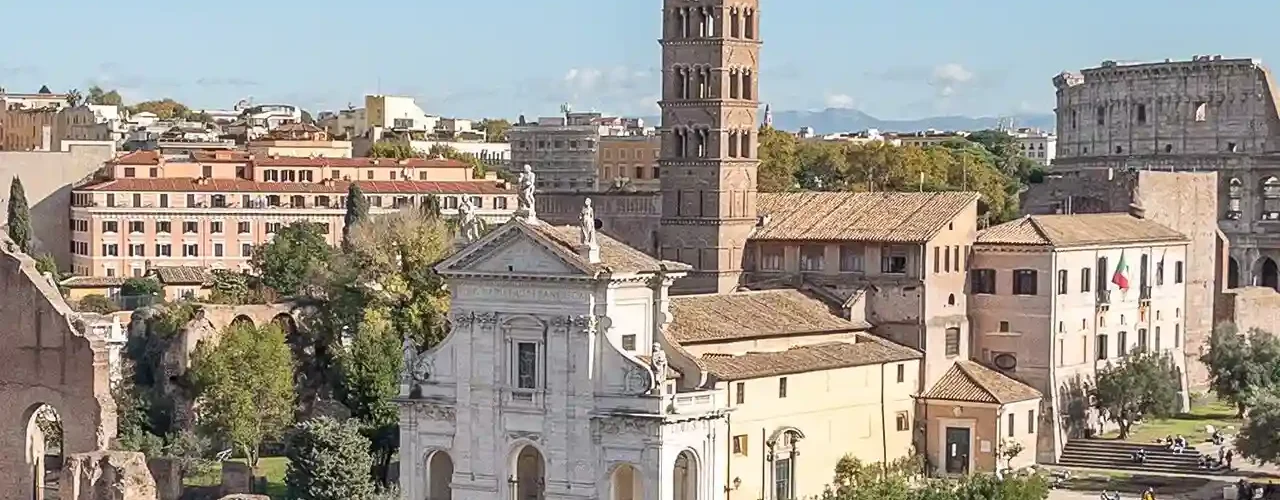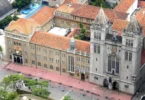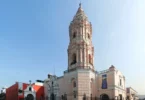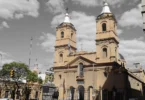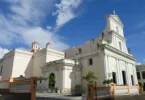Introduction
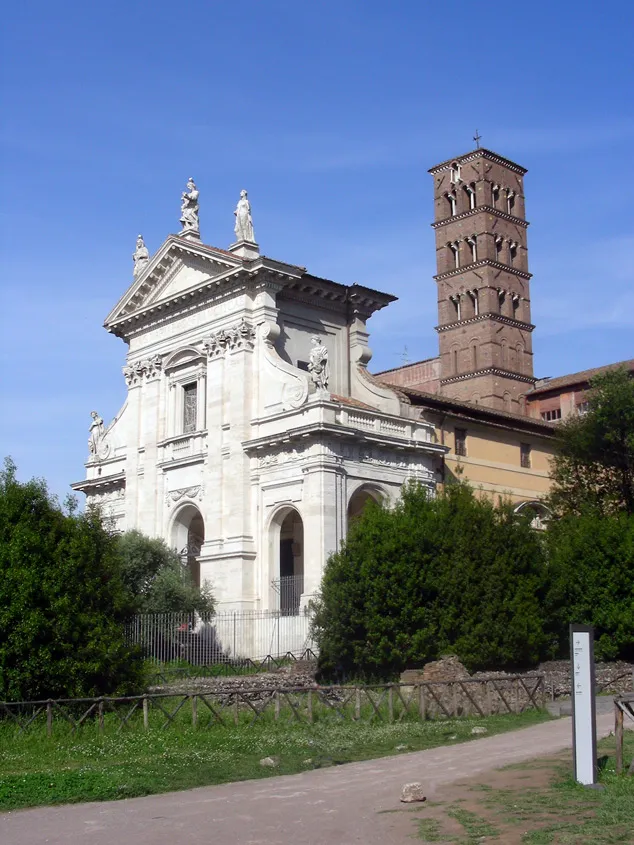
The Basilica of Santa Francesca Romana (Italian: Basilica di Santa Francesca Romana), formerly known as Santa Maria Nova, is a historic Catholic church located in the heart of Rome, Italy. Situated adjacent to the Roman Forum in the rione Campitelli, the basilica lies in close proximity to significant ancient Roman landmarks. It faces the Colosseum and stands next to the ruins of the Basilica of Maxentius, one of the grand structures of ancient Rome. Originally dedicated as Santa Maria Nova in the 6th century, the church was later renamed in honor of Saint Frances of Rome (Santa Francesca Romana), a 14th-century noblewoman and mystic who founded the Oblates of Mary. Saint Frances became one of the most revered saints of Rome, and her influence led to the church’s dedication in her name.
This basilica is also the final resting place of Pope Gregory XI, known for his pivotal role in bringing the papacy back to Rome from Avignon, where it had been based for nearly 70 years. His tomb is one of the church’s important historical features. As a place of worship and a monument to both early Christian and Renaissance architecture, the Basilica of Santa Francesca Romana stands as a vital link between Rome’s ancient past and its enduring religious traditions. Its proximity to the Colosseum and the Roman Forum places it at the center of the city’s rich historical and cultural heritage, making it an important destination for both pilgrims and visitors.
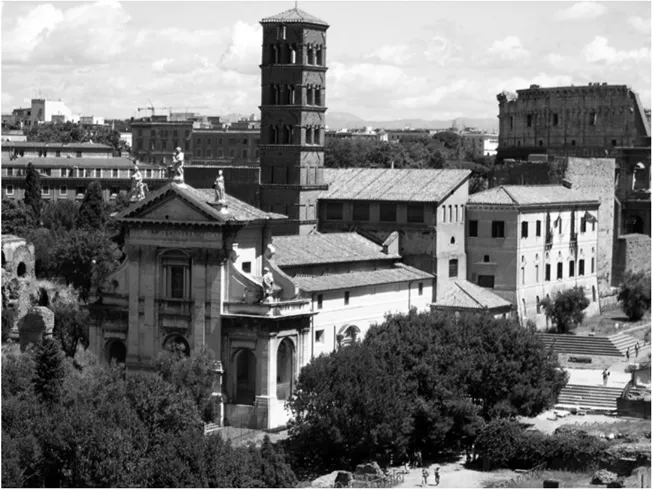
Origins and Early Development:
The Basilica of Santa Francesca Romana, originally known as Santa Maria Nova, traces its origins to the 8th century, with the establishment of an oratory by Pope Paul I. This early structure was erected in the portico of the Temple of Venus and Roma, a monumental structure in ancient Rome. According to tradition, the site is significant for an event involving Saint Peter and Simon Magus, a legendary figure in early Christianity. Legend has it that Simon Magus, wishing to prove his superiority over the apostles, attempted to levitate before Saint Peter. The apostle, praying for divine intervention, caused Simon to fall to the ground, where he died. It is said that the basalt stones where Peter’s knees touched during his prayer are embedded in the wall of the church’s south transept.
By the 10th century, a church had been established at this site and was dedicated to Santa Maria Nova (“New St. Mary”) to distinguish it from Santa Maria Antiqua, another church within the Roman Forum that had fallen into disrepair. The relics of the ancient church were moved to Santa Maria Nova under Pope Leo. During the second half of the 10th century, the church was enlarged, and later, in the 13th century, Pope Honorius III oversaw its reconstruction. This renovation included the addition of a campanile (bell tower) and an apse, as well as a mosaic of the Maestà, depicting the Madonna enthroned with saints.
Ownership and Renovations:
Since 1352, the church has been under the care of the Olivetans, a religious order. In the 16th century, the church was rededicated to Saint Frances of Rome (Saint Francesca Romana), who was canonized in 1608. Her relics were placed in the church’s crypt. Over the centuries, the church underwent various refurbishments, notably the travertine porch and façade designed by Carlo Lambardi in 1615.
16th to 19th Century Changes:
In the 16th century, the church was rededicated to Saint Francesca Romana. The relics of Saint Frances, as well as those of other saints, were enshrined in the church. This period also marked the completion of significant architectural alterations. Gian Lorenzo Bernini contributed to the creation of the confessio, the enclosed area beneath the altar, between 1638 and 1649. At its center, Bernini designed a sculptural group depicting Saint Frances and an angel. However, the original sculpture was lost during the French occupation of Rome in 1798, and it was replaced in 1866 by a work by sculptor Giosuè Meli.
In 1870, after the unification of Italy and the conquest of Rome, the Olivetans lost much of their property, including the annexed monastery, which was expropriated by the newly formed Italian state. The Antiquarium Forense, an archaeological museum, was created on the site by Giacomo Boni in the early 20th century, using the space previously occupied by the monastery.
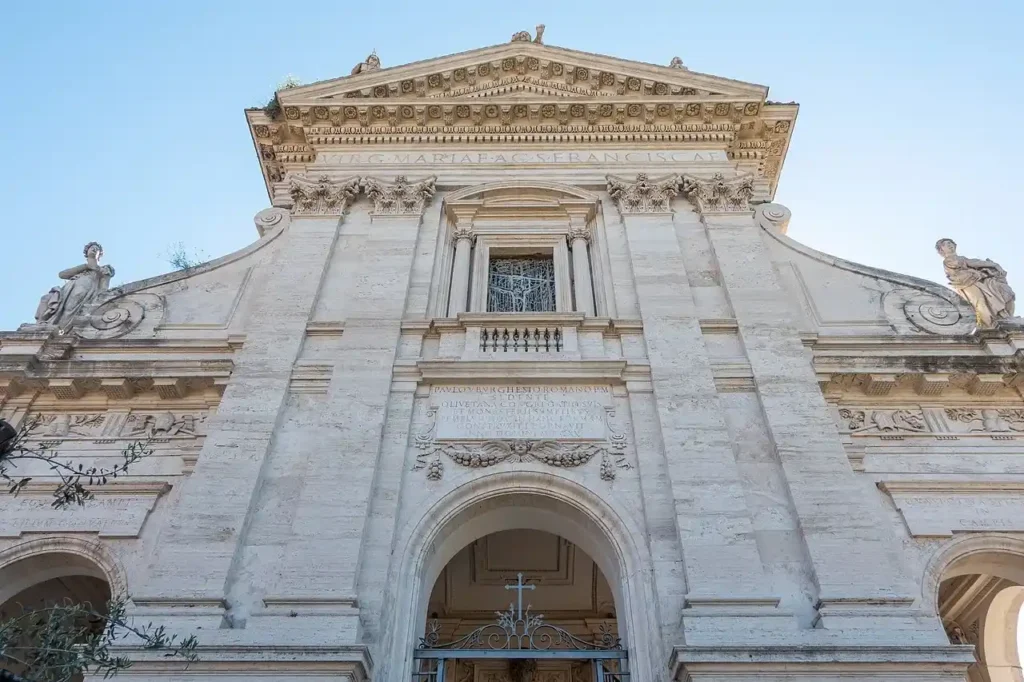
Architect : Carlo Lambardi
Architectural Styles : Romanesque architecture
Burials : Pope Gregory XI, Giambattista Orsini, Enrico Sibilia
Exterior Layout and Fabric
Santa Francesca Romana follows a basilical plan, featuring a nave and five bays with side aisles converted into chapels. The campanile, a Romanesque structure from the 12th century, is inserted into the fifth bay, next to the left aisle. The sanctuary is positioned as a sixth bay, with its apse included in the monastic cloister buildings. A disused side entrance once connected to the medieval monastic range and is now accessed by two transverse staircases due to ground level changes. The church’s facade and loggia, designed by Carlo Lombardi, are made of travertine, with the brick exterior of the nave rendered in light orange.
Campanile
Standing on the left side of the church, the campanile was erected in the mid-12th century. Made of brick, it rises with five stories, separated by projecting cornices. The first two levels have double arches, while the upper levels feature double arched sound holes and decorative elements like crosses and roundels. At the top, small aedicules likely intended for mosaics add a further decorative touch.
Facade
The facade, designed by Carlo Lombardi, serves as a monumental propylaeum with recessed kiosks on either side. Gigantic Composite pilasters frame the central arch, leading to a loggia above. The façade features inscriptions dedicated to the Virgin Mary, St. Frances, and the Olivetan Order, incorporating symbolic references such as olive trees and coats of arms related to Monte Oliveto Abbey.
Interior Layout and Fabric
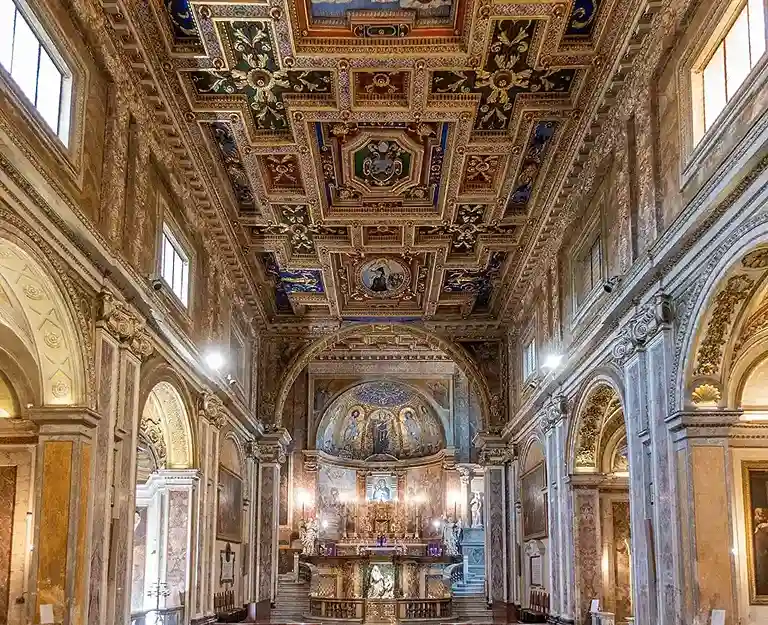
Inside, Santa Francesca Romana showcases Baroque decoration with a wooden coffered ceiling painted in red, blue, and gold. The nave is supported by Ionic pilasters, and the floor retains some 13th-century Cosmatesque pavement, though much of it was restored in 1953. The church also houses a newly constructed organ, installed in the 1970s, with the monastic choir positioned above the entrance.
Confessio and Sanctuary
The confessio, initially designed by Bernini and completed in 1649, is an enclosed space in front of the sanctuary, framed by fluted columns of red and white Sicilian jasper. The sculpture of St. Frances and her angel, created in 1866, is displayed here. The sanctuary features a Cosmatesque floor, with the apse decorated with a 12th-century mosaic of the Madonna and Child surrounded by apostles. The high altar, flanked by frescoes and statues, also houses the tomb of Pope Gregory XI, who returned the papacy to Rome.
Sacristy and Relics
The sacristy, decorated in the 18th century, is home to a collection of oil paintings, including works by Perino del Vaga and Pierre Subleyras. It also preserves fragments of medieval mosaics. In the crypt, the relics of St. Frances are displayed in a glass-fronted loculus. Her skeleton, dressed in the habit of the Oblate Sisters, is visible, along with a 17th-century bas-relief of St. Frances with her guardian angel.
Architectural Description
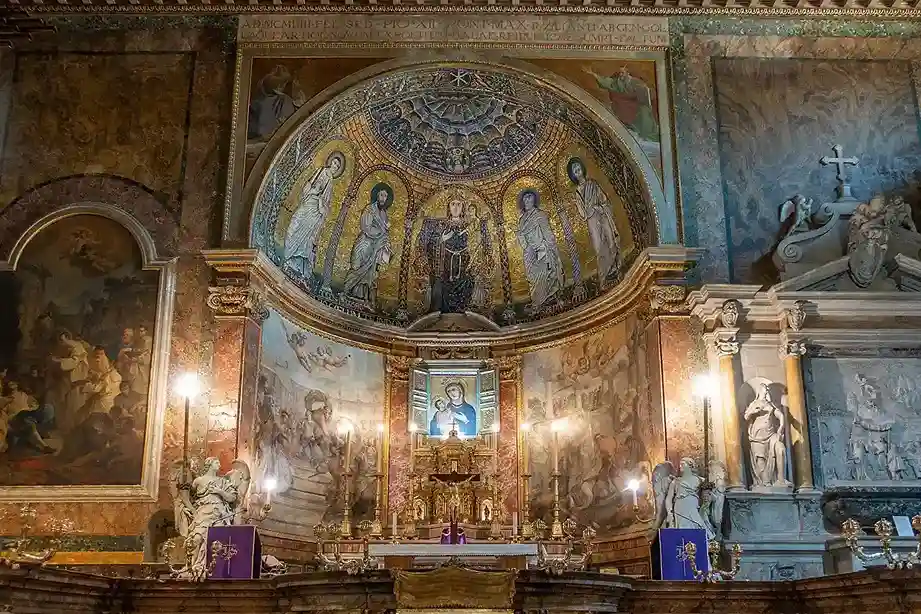
The church’s facade, designed by Carlo Lombardi in 1615, is crafted from travertine, and it blends Christian and ancient Roman architectural elements, with remnants of the Temple of Venus and Roma providing a dramatic backdrop. The interior features a single nave with side chapels and an area decorated with Cosmatesque mosaics. The sacristy houses religious artifacts, including the early 5th-century Madonna Glycophilousa (“Our Lady of Tenderness”), moved from Santa Maria Antiqua.
Apse and Mosaics
One of the church’s most striking features is its apse mosaic, dating from the 9th century. This early Christian mosaic, along with the triumphal arch decoration, provides a vivid historical and artistic element, showcasing the church’s heritage in early Christian art.
Notable Burials
Santa Francesca Romana serves as the final resting place for Pope Gregory XI, who returned the papacy to Rome from Avignon. His tomb, designed by Pietro Paolo Olivieri in 1584, includes a central panel depicting Gregory’s return. The painter Gentile da Fabriano is also buried in the church, and though his tomb no longer exists, a plaque commemorates his burial here.
Feast Day and Patronage
Santa Francesca Romana is the patron saint of drivers, based on a legend that an angel would light her way at night with a lamp. On her feast day, March 9, automobiles line up for a blessing, stretching as far as the Colosseum. The church remains a significant site for pilgrims and visitors in Rome.
Chapel Art and Monuments of Santa Francesca Romana
The chapels of Santa Francesca Romana are richly adorned with artwork and monuments reflecting the church’s religious heritage. The Chapel of the Crucifixion features an anonymous altarpiece of the Calvary and side wall paintings by Giuseppe Maria Crespi Lo Spagnolo. The side entrance vestibule holds the tombs of Marino Cardinal Vulcano, designed by Paolo Romano, and Antonio da Rio, depicting the knight on horseback. The Chapel of St Benedict, with an altarpiece by Augusto Orlandi, depicts St Benedict alongside SS Henry the Emperor and Francesca Romana, while the Chapel of St Frances of Rome, refitted in 1729, contains an anonymous altarpiece and a Bernini-inspired holy-water basin. The Chapel of St Bernard Tolomei, decorated with polychrome marble, includes a deathbed scene painted by Giuseppe Pirovani, and the Chapel of Our Lady of Sorrows once held a marble Pietà, now relocated to Germany. The Chapel of St Gregory the Great features an altarpiece by Angelo Caroselli, while the Chapel of the Nativity, with a copy of Carlo Maratta’s altarpiece and paintings by Domenico Maria Canuti, depicts scenes from St Bernard Tolomei’s life, including one with St Michael driving away the Devil.
Feast Day
Feast Day: 9th March
The feast day of Santa Francesca Romana is celebrated on March 9th. This day honors the life and legacy of St. Frances, who founded the Oblate Sisters of Mary and was dedicated to charitable works in Rome during the 14th century.
Church Mass Timing
Sunday : 11:00 AM
Church Opening Time:
Monday : 10:00 am – 05:00 pm
Tuesday : 10:00 am – 05:00 pm
Wednesday : 10:00 am – 05:00 pm
Thursday : 10:00 am – 05:00 pm
Friday : 10:00 am – 05:00 pm
Saturday : 10:00 am – 05:00 pm
Sunday : 10:00 am – 05:00 pm
Contact Info
Address :
Piazza di Santa Francesca Romana, 4, 00186 Roma RM, Italy.
Phone : +39066795528
Accommodations
Connectivities
Airway
Leonardo da Vinci International Airport (FCO), 00054 Fiumicino RM, Italy to Basilica of Santa Francesca Romana, Rome, Italy distance between 29 min (26.6 km) via A91.
Railway
Stazione FS di Roma Termini, Via Giovanni Giolitti, to Basilica of Santa Francesca Romana, Rome, Italy distance between 14 min (3.8 km) via Via di S. Gregorio.

